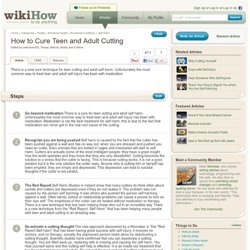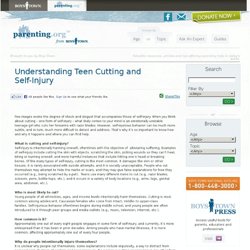

How to Cure Teen and Adult Cutting. Edit Edited by Username152, Teresa, Maluniu, Puddy and 6 others There is a new cure technique for teen cutting and adult self harm.

Unfortunately the most common way to treat teen and adult self injury has been with medication Edit Steps 1 Go beyond medication :There is a cure for teen cutting and adult self harm. Edit Warnings Medication can be of good help and can save your life but do not stop at medication; learn to de-active the cutting thought and fill back up Categories: Self Harm Recent edits by: Tiagoroth, Charles Carter, Henija. Understanding Teen Cutting and Self-Injury. ShareThis Few images evoke the degree of shock and disgust that accompanies those of self-injury.

When you think about cutting – one form of self-injury – what likely comes to your mind is an emotionally unstable teenage girl who cuts her forearms with razor blades. However, self-injurious behavior can be much more subtle, and in turn, much more difficult to detect and address. That’s why it’s so important to know how and why it happens and where you can find help. What is cutting and self-injury? Who is most likely to cut? How common is it? Why do people intentionally injure themselves? What are the risk factors and signs to watch for? Risk Factors Knowledge that friends or acquaintances are cutting Difficulty expressing feelings Extreme emotional reactions to minor occurrences (anger or sorrow) Stressful family events (divorce, death, conflict) Loss of a friend, boyfriend/girlfriend, or social status Negative body image Lack of coping skills Signs What should you do?
Helping Teens Who Cut. Listen Cutting — using a sharp object like a razorblade, knife, or scissors to make marks, cuts, or scratches on one's own body — is a form of self-injury.

It can be hard to understand why anyone would hurt himself or herself on purpose. Learning that your own teen is doing it can leave you feeling shocked and upset — and not sure what to do or how to help. About Cutting For most, cutting is an attempt to interrupt strong emotions and pressures that seem impossible to tolerate. Cutting affects many teens and preteens — even beyond those who self-injure. In many cases, cutting — and the emotions that go along with it — is something teens struggle with alone. Parents can help teens who cut — and the earlier, the better. What Parents Can Do If your teen is cutting, there ways to help. Accept your own emotions. Take time to identify your own feelings and find a way to express them. Learn all you can about cutting.
It can hurt to think that your child might experience any of these feelings. Cutting. Listen How Does Cutting Start?

Cutting often begins on an impulse. It's not something the person thinks about ahead of time. Shauna says, "It starts when something's really upsetting and you don't know how to talk about it or what to do. But you can't get your mind off feeling upset, and your body has this knot of emotional pain. Natalie, a high-school junior who started cutting in middle school, explains that it was a way to distract herself from feelings of rejection and helplessness she felt she couldn't bear. Sometimes self-injury affects a person's body image. You can't force someone who self-injures to stop. Pressured to Cut? Girls and guys who self-injure are often dealing with some heavy troubles.
Tia tried cutting because a couple of the girls at her school were doing it. If you have a friend who suggests you try cutting, say what you think. Lindsay had been cutting herself for 3 years because of abuse she suffered as a child.